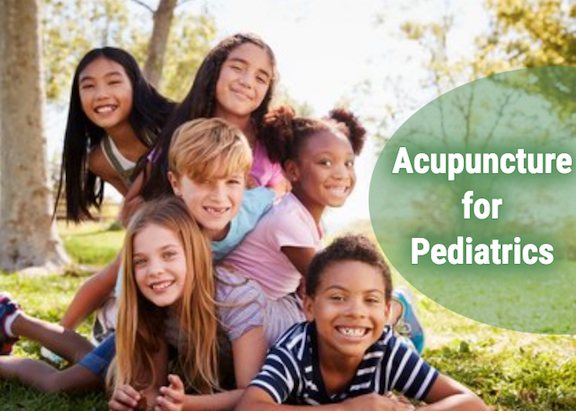Pediatric acupuncture is becoming increasingly popular in the United States as many parents are seeking more holistic methods of treatment to support their child’s health. Not only that, but its popularity is also thanks to the science that backs up its safety and benefits year after year. Parents are also keen on the thought of acupuncture as being their first line of defense against common child ailments such as allergies and stomach aches. In this article we will explore how to approach pediatric acupuncture in your office.
Acupuncture Works for Kids
Acupuncture works the same way as it does in adults by stimulating a neurobiological process that allows the body to release feel-good hormones, and activate the body’s self-healing properties. Some parents think acupuncture is just for pain, but acupuncture works for children and teens for a wide variety of issues.
Acupuncture for Kids helps with:
- Anxiety/depression (or other emotional issues)
- Sleep problems
- Fatigue
- Headaches
- Bone or joint pain
- Allergies
- Nausea, reflux, stomach pain
- ADHD
- Bedwetting
- Drooling
- Colic
The benefits of acupuncture work quickly in children, which also draws parents to it for treatment. The difference between kids and adults, however, is that while the effects of acupuncture treatment are the same, the needling technique and length of time the needles are in is vastly different. As we know, acupuncture can treat many conditions unique to children, but it is imperative, especially with pediatric acupuncture gaining popularity, that we as acupuncturists follow safe and appropriate practice guidelines when performing acupuncture on children.
Acupressure Points for Kids
While we know that acupuncture points used will be dependent on the condition the child comes to us with, there are some great acupressure points that are very successful with children to provide for parents to use at home.
Acupressure points for kids:
- LI4 – improves intestinal function and helps alleviate diarrhea, constipation, and abdominal pain.
- ST36 – immune system and energy boosting point, as well as helping with digestive issues.
- Yin Tang – this is a classic calming point. Decreases stress, relieves sinus pressure, and watery eyes.
- DU20 – this is a powerful point as it raises emotional energy therefor decreasing depression and anxiety.
- DU12 – this is one of the most calming points for children.
- PC6 – nausea and vomiting.
- UB2 – alleviates hiccups
- LI3 – sore throats, headaches, insomnia, congestion, depression, dizziness, vertigo, toothache, and eye pain/swelling.
Additionally, there are specific acupressure points for colicky babies that research shows to be effective.
Acupressure points for colicky babies:
- LI2
- BL47
- K3
- PC3
- LI3
As we said above, children tend to respond quickly to acupressure so providing these as a tool for parents to use at home would be helpful if you’re taking on pediatric acupuncture. All of these acupressure points can be done while bathing, nursing, or dressing the baby, and should be used 1-3 times a day and no more than 15 minutes total. The parent should be advised to use gentle circular motions, and spend more than 30 seconds on any one acupressure point.
Acupuncture & Kids
Chronic childhood conditions are increasing with 13-27% of children now being affected by them, and these conditions may last into adulthood. This fact alone makes it unsurprising that many families are turning to acupuncture for treatment for their child’s conditions. Acupuncture for children can be very rewarding, at times even frustrating, and help with your overall client base not only in numbers, but in their trust with you as their acupuncturist. As acupuncturists we are committed to the whole health of the individual, and know how beneficial acupuncture treatment is especially when getting it as soon as possible.
Treating the child through childhood into adulthood will set them up for health success, and there is no greater feeling than knowing you had a hand in their health. Above all, and most importantly, if you want to add pediatric acupuncture to your practice, you need to love kids! If your enthusiasm and energy reflect your work to help them heal or maintain their health, any challenges that may arise with the child can be conquered.
To learn more about Acupuncture for Pediatrics, and earn 2 CEUs/PDAs, click here.

Have more knowledge or an acupuncture/TCM specialty you want to call attention to and share?
Become our next Acupuncturist of the Month!
Share your knowledge, highlight your work, and lift up the acupuncture profession for you and other professionals!
Email us at acucontinuingeducation@gmail.com or click here today to learn more.
References:
National Institutes of Health. (January 16,2017). Effect of Minimal Acupuncture for Infantile Colic.
National Institutes of Health. (May 31, 2016). Chronic Conditions in Children and Young People.
ABC – Nexstar Broadcasting. (April 8, 2019). Acupressure Points for Babies that Every Parent Should Know.
Intermountain Healthcare. (January 26, 2018). Acupressure for Kids.
Mukherjee, B. (2020). Important Acupressure Points for Babies and Kids.
Wikipedia. (August 14, 2020). Pediatrics.
Saunders, N. (2020). Evidence Summary: Pediatric Acupuncture.
Fitzpatrick, C. (January 21, 2016). Acupuncture Provides Relief for Children with Chronic Pain.
Fitzpatrick, C. (August 24, 2016). Acupuncture for Kids? Study Says Yes.
Pacific College of Oriental Medicine. (2020). The Benefits of Acupuncture for Children.

